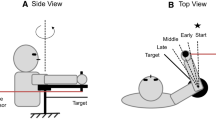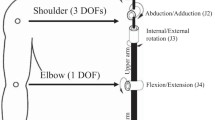Abstract
In cerebellar ataxia, kinematic aberrations of multijoint movements are thought to originate from deficiencies in generating muscular torques that are adequate to control the mechanical consequences of dynamic interaction forces. At this point the exact mechanisms that lead to an abnormal control of interaction torques are not known. In principle, the generation of inadequate muscular torques may result from an impairment in generating sufficient levels of torques or from an inaccurate assessment and prediction of the mechanical consequences of movements of one limb segment on adjacent joints. We sought to differentiate the relative contribution of these two mechanisms and, therefore, analyzed intersegmental dynamics of multijoint pointing movements in healthy subjects and in patients with cerebellar degeneration. Unrestrained vertical arm movements were performed at three different target movement velocities and recorded using an optoelectronic tracking system. An inverse dynamics approach was employed to compute net joint torques, muscular torques, dynamic interaction torques and gravitational torques acting at the elbow and shoulder joint. In both groups, peak dynamic interaction forces and peak muscular forces were largest during fast movements. In contrast to normal subjects, patients produced hypermetric movements when executing fast movements. Hypermetric movements were associated with smaller peak muscular torques and smaller rates of torque change at elbow and shoulder joints. The patients’ deficit in generating appropriate levels of muscular force were prominent during two different phases of the pointing movement. Peak muscular forces at the elbow were reduced during the initial phase of the movement when simultaneous shoulder joint flexion generated an extensor influence upon the elbow joint. When attempting to terminate the movement, gravitational and dynamic interaction forces caused overshooting extension at the elbow joint. In normal subjects, muscular torque patterns at shoulder and elbow joint were synchronized in that peak flexor and extensor muscular torques occurred simultaneously at both joints. This temporal pattern of muscular torque generation at shoulder and elbow joint was preserved in patients. Our data suggest that an impairment in generating sufficient levels of phasic muscular torques significantly contributes to the patients’ difficulties in controlling the mechanical consequences of dynamic interaction forces during multijoint movements.
Similar content being viewed by others
Author information
Authors and Affiliations
Additional information
Received: 28 October 1996 / Accepted: 30 September 1997
Rights and permissions
About this article
Cite this article
Topka, H., Konczak, J., Schneider, K. et al. Multijoint arm movements in cerebellar ataxia: Abnormal control of movement dynamics. Exp Brain Res 119, 493–503 (1998). https://doi.org/10.1007/s002210050365
Issue Date:
DOI: https://doi.org/10.1007/s002210050365




